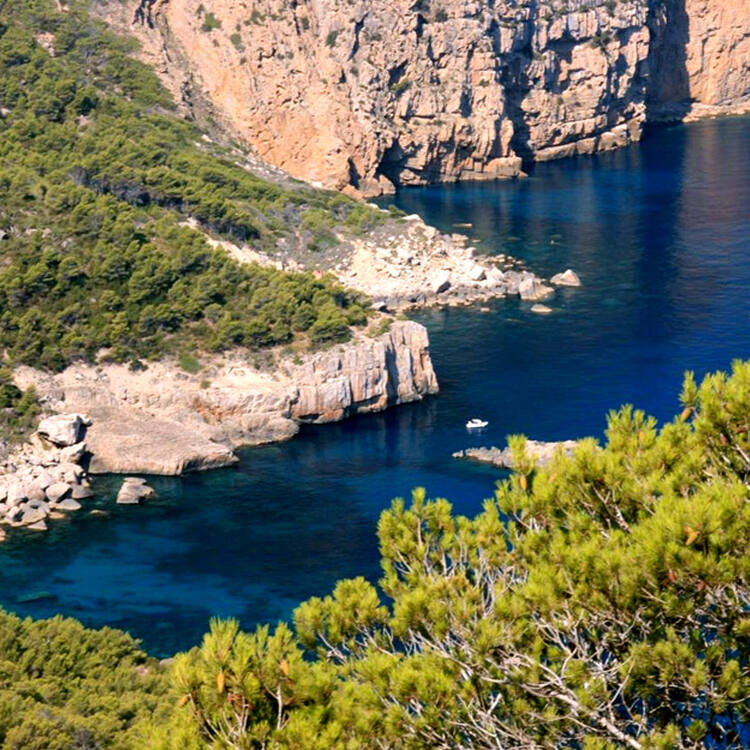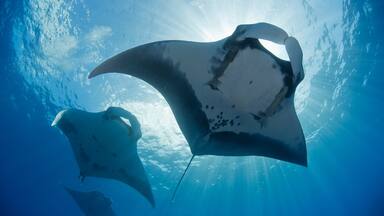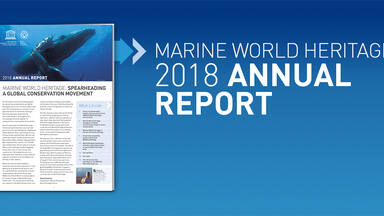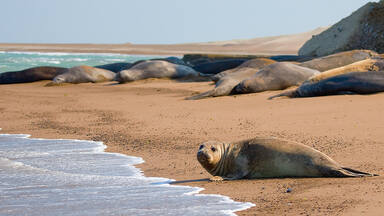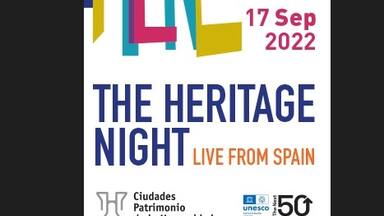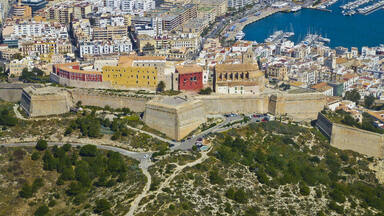Ibiza, Biodiversity and Culture
Ibiza, Biodiversity and Culture
Ibiza provides an excellent example of the interaction between the marine and coastal ecosystems. The dense prairies of oceanic Posidonia (seagrass), an important endemic species found only in the Mediterranean basin, contain and support a diversity of marine life. Ibiza preserves considerable evidence of its long history. The archaeological sites at Sa Caleta (settlement) and Puig des Molins (necropolis) testify to the important role played by the island in the Mediterranean economy in protohistory, particularly during the Phoenician-Carthaginian period. The fortified Upper Town (Alta Vila) is an outstanding example of Renaissance military architecture; it had a profound influence on the development of fortifications in the Spanish settlements of the New World.
Description is available under license CC-BY-SA IGO 3.0
Ibiza, biodiversité et culture
Ibiza offre un excellent exemple d'interaction entre les écosystèmes marins et côtiers. Les prairies denses de posidonies (herbe des fonds marins), espèce endémique que l'on trouve uniquement dans le bassin méditerranéen, contiennent et entretiennent une vie marine diverse. Ibiza conserve des témoignages considérables de sa longue histoire. Les sites archéologiques de Sa Caleta (habitat) et de Puig des Molins (nécropole) témoignent de l'importance du rôle joué par l'île dans l'économie méditerranéenne de la protohistoire et, tout particulièrement, au cours de la période phénicienne-carthaginoise. La ville haute fortifiée (Alta Vila) est un exemple exceptionnel d'architecture militaire de la Renaissance. Elle a eu une profonde influence sur le développement des fortifications dans les établissements espagnols du Nouveau Monde.
Description is available under license CC-BY-SA IGO 3.0
إيبيزا، تنوّع بيولوجي وثقافة
تشكّل إيبيزا خير مثال عن التفاعل بين النظم البيئيّة البحريّة الشاطئيّة. وتحتوي مروج عشبة البحر وهي صنف مستوطن متوفّر فقط في حوض البحر الأبيض المتوسّط، على حياة بحريّة متنوّعة. تحافظ إيبيزا على قرائن حيّة لتاريخها الطويل. وتشهد مواقع مسكن سا كاليتا الأثريّة وبيغ ديس مولين وهي مدينة الموتى على الدور العظيم الذي أدّته الجزيرة في الاقتصاد المتوسطي لتاريخ نشوء البشريّة وخصوصاً في خلال الفترة الممتدة بين الحقبة الفينيقيّة والقرطاجيّة. وتشكّل المدينة المحصّنة العالية (ألتا فيلا) مثالاً استثنائياً عن الهندسة العسكريّة في حقبة النهضة. ولقد أحدثت تأثيراً بالغاً في تطوّر الحصون ومؤسسات العالم الحديث الإسبانيّة.
source: UNESCO/CPE
Description is available under license CC-BY-SA IGO 3.0
伊维萨岛的生物多样性和特有文化
伊维萨岛的生物多样性和特有文化提供了一个海洋生态系统和沿海生态系统之间相互作用的极好范例。伊维萨岛边地中海盆地所特有的波西多尼亚海草生长茂盛,蕴含和支撑着海洋生物的多样性。另外,伊维萨岛的历史遗迹保存完好。萨·卡莱塔聚居地考古遗址和普伊格·德斯·墨林斯墓地遗址证实了一点:在史前,特别是腓尼基-迦太基时期,伊维萨岛对于地中海经济发展起到了非常重要的作用。坚固的高城要塞是文艺复兴时期军事建筑的杰出范例,对于西班牙殖民者在新大陆的防御性建筑发展具有极其深远的影响。
source: UNESCO/CPE
Description is available under license CC-BY-SA IGO 3.0
Остров Ибиса: биоразнообразие и культура (Балеарские острова)
Ибиса (Ивиса, Ибица) дает прекрасный пример взаимодействия между морскими и береговыми экосистемами. Густые заросли посидонии (океанической водоросли), одного из главных эндемиков Средиземного моря, – важное условие поддержания видового многообразия морских организмов в прибрежной зоне. Ибиса хранит свидетельства своей богатой истории. Археологические раскопки в районе поселения Са-Калета и в некрополе Пуйг-дес-Молинс подтверждают, что остров играл большую роль в экономическом развитии Средиземноморья даже в доисторическую эпоху, особенно во времена Финикии и Карфагена. Укрепленный Верхний город (Альта-Вила) – выдающийся пример военной архитектуры эпохи Возрождения, оказавший большое влияние на сооружение испанских укрепленных поселений в Новом Свете.
source: UNESCO/CPE
Description is available under license CC-BY-SA IGO 3.0
Ibiza, biodiversidad y cultura
Esta isla ofrece un excelente ejemplo de la interacción entre los ecosistemas marinos y costeros. Sus tupidas praderas de posidonias –planta de los fondos marinos endémica de la cuenca mediterránea– ofrecen refugio y alimentación a muy diversas especies marinas. Además, Ibiza conserva vestigios considerables de su larga historia. Los sitios arqueológicos del asentamiento humano de Sa Caleta y de la necrópolis del Puig des Molins atestiguan el importante papel desempeñado por la isla en la economía del mediterránea de la Protohistoria, y más concretamente del periodo fenicio-cartaginés. La Alta Vila, extraordinaria muestra de la arquitectura militar renacentista, ejerció una gran influencia en la concepción de las fortificaciones de los asentamientos españoles en el Nuevo Mundo.
source: UNESCO/CPE
Description is available under license CC-BY-SA IGO 3.0
イビサ、生物多様性と文化
スペイン東部、バレアレス諸島南西部に位置する島。南東岸の中心都市イビザはカルタゴ人が建設し、古代ローマ人・アラブ諸族が占領したことから、古代遺跡や各時代の建造物が多く、海上からの景観が見事である。島には地中海地域に固有の貴重な植物生態系が見られる。またモンクアザラシなど3種の絶滅の危機に瀕している動物、205種の鳥類、56種の無脊椎動物、その他の生物多様性に恵まれている。地質学的に重要な無数の洞穴も存在する。source: NFUAJ
Ibiza, biodiversiteit en cultuur
Ibiza is een goed voorbeeld van de interactie tussen de ecosystemen van de zee en de kust. De dichte prairies van Posidonia Oceanica, een inheemse zeegrassoort die alleen in het Middellandse Zee-gebied voorkomt – ondersteunen de diversiteit van het zeeleven. De archeologische plekken Sa Caleta en Puig des Molins laten zien dat het eiland een belangrijke rol speelde in de vroege geschiedenis van de mediterrane economie. De versterkte bovenstad (Alta Vila) is een mooi voorbeeld van militaire architectuur in Renaissancestijl. De stad heeft grote invloed uitgeoefend op de ontwikkeling van vestingwerken in de Spaanse nederzettingen van de Nieuwe Wereld.
Source: unesco.nl
Outstanding Universal Value
Brief synthesis
Ibiza, Biodiversity and Culture, is a serial, mixed natural and cultural World Heritage property bringing together exceptional archaeological and historic sites on the islands of Ibiza, adjacent to a marine reserve of global importance. It covers 9,020 ha, mostly sea.
The fortified Upper Town (Dalt Vila) is an outstanding example of Renaissance military architecture, built to defend communications between Spain and Italy. Between 1554 and 1585, new fortifications were built by two Italian engineers: Giovanni Battista Calvi and Jacobo Paleazzo Fratin. These defences influenced the development of Spanish fortifications in America. More than 2,500 years old, the Upper Town preserves a labyrinth of streets, alleys and passageways recalling its medieval layout, and historical buildings of great interest like the Cathedral, the University, the Almudaina Castle and the Santo Domingo convent.
The settlement of Sa Caleta preserves significant archaeological evidence of the urban development of the first Phoenician occupation in the eighth century BC. At the beginning of the sixth century, its inhabitants abandoned this site and moved to the site now occupied by Dalt Vila in the Bay of Ibiza.
The Punic necropolis at Puig des Molins covers more than 5 ha. It has more than 5,000 graves using different funeral rites from the Punic, Roman and Islamic eras. Burial vaults are the most abundant and characteristic Punic type. Artefacts, including pottery, terracotta figurines, beetles, ostrich eggs, enable assessment of trade between Punic Ibiza, and other Phoenician Punic and Greek, Roman, Iberian, and Egyptian sites.
The property’s natural values are characterised by the best-conserved marine meadows of Posidonia Oceanica (Neptune Grass) in the Mediterranean. Neptune Grass is unique to the Mediterranean basin, and its presence is essential for ecological processes between marine and coastal ecosystems, due to the action caused by the accumulation of Neptune Grass on the beach, which protects its stability. Neptune Grass meadows provide an oasis for a rich marine biodiversity including a number of endemic and threatened species.
Criterion (ii): The intact 16th century fortifications of Ibiza bear unique witness to the military architecture and engineering and the aesthetics of the Renaissance. This Italian-Spanish model was very influential, especially in the construction and fortification of towns in the New World.
Criterion (iii): The Phoenician ruins of Sa Caleta and the Phoenician-Punic cemetery of Puig des Molins are exceptional evidence of urbanization and social life in the Phoenician colonies of the western Mediterranean. They constitute a unique resource, in terms of volume and importance, of material from the Phoenician and Carthaginian tombs.
Criterion (iv): The Upper Town of Ibiza is an excellent example of a fortified acropolis which preserves in an exceptional way in its walls and in its urban fabric successive imprints of the earliest Phoenician settlements and the Arab and Catalan periods through to the Renaissance bastions. The long process of building the defensive walls has not destroyed the earlier phases or the street pattern but has incorporated them in the ultimate phase.
Criterion (ix): The marine component of this property is characterised by the presence of dense and very well-preserved Posidonia Oceanica (Neptune Grass) meadows and Cushion Coral (or Mediterranean coral) reefs. The Posidonia Oceanica (Neptune Grass) of this site is defined as the best preserved out of the Mediterranean area. The property includes important coastal lagoon and wetland ecosystems as well as halophyte communities, which also support important water bird populations. The evolution of Ibiza’s shoreline is one of the best examples of the influence of Posidonia Oceanica (Neptune Grass) on the interaction of coastal and marine ecosystems.
Criterion (x): The exceptionally dense and well-preserved Posidonia Oceanica (Neptune Grass) meadows support a diverse fauna of invertebrates and fish, and provide important spawning and nursery habitats, including to endemic and threatened species. The coastal and terrestrial parts of the site boast several endemic plant species, including rare and vulnerable species. The property is also home to the most diverse community of Mediterranean Pillow Coral in the Mediterranean, and houses an important community of Mangrove Tunicate, a marine species that is acknowledged to be of value in preventing and combating different kinds of cancer. Some of the property’s component parts are also important for migratory birds.
Integrity
The World Heritage property includes all cultural elements necessary to express its Outstanding Universal Value. It is of adequate size to include the features and processes which convey the property’s significance - significance that might spread to certain elements of the buffer zone, such as Ses Feixes and the ancient saltpans of Las Salinas, whose future inclusion in the property is being considered.
The attributes of Outstanding Universal Value of the cultural heritage of the property are in a satisfactory condition at the time of inscription. In order to prevent the World Heritage property from suffering from adverse effects of development, an integrated monitoring system is necessary as the archaeological remains and natural features of the property are fragile, and tourism and development needs to be controlled.
The boundaries of the property are sufficient to conserve its exceptional marine life and ecological processes, which are the result of the presence of Neptune Grass meadows and Cushion Coral (or Mediterranean coral) reefs. The property’s exceptional density of Neptune Grass, which only flowers and spreads under optimal conditions, oxygenates the waters, keeping them clean and clear, while sheltering the beaches from the erosive effects of the waves and maintaining the natural dynamics of the dune systems. The result of the continuous and regular biological process is the formation of reefs of Neptune Grass that make up actual natural monuments beneath the water. Invasive species control, particularly of aggressive seaweed, which has destroyed Neptune Grass meadows elsewhere in the Mediterranean, is essential.
Authenticity
Archaeological excavations have not affected the authenticity of the Phoenician and Punic cemeteries. The monuments have not been reconstructed. Although certain openings were made in the hypogea to enable visitor access, but this happened long ago and can be considered as part of the history of the site. After burials ceased, the cemeteries became agricultural land. Thanks to its early acquisition and protection by the State (in 1931), it has become a green space in the middle of the city.
The authenticity of the Upper Town is more complex. Changes have been made regularly to meet the social needs of its residents, an important factor for preserving the living character of the town. In this respect, the height and size of certain walls are a determining factor to safeguard the physiognomy of the town. On the whole, the urban structure is intact, and the determination to improve living conditions is positive. The materials and the forms of the 16th century walls are authentic.
The authenticity of the design is shown by historical cartography of the 16th and 17th centuries. Scarce urban development in the city in the 18th and 19th centuries and the maintenance of its military function practically until the 1970s have favoured its exceptional conservation.
Protection and management requirements
Protection of cultural values is ensured through different legal statutes. The fortified area of Ibiza is a “National Monument” since 1942. In 1969, the city of Ibiza was recognised as a “historical-artistic monument”. The protection of this monument is ensured by the Special Plan for Protection and Interior Reform (PEPRI), in compliance with the State Heritage Law and complemented by the General Plan for Urban Zoning.
The Necropolis of Puig des Molins is a “National Monument” since 1931, whose protection is supplemented by a special Decree. The Phoenician settlement at Sa Caleta is an “Asset of Cultural Interest” since 1993.
Several different national, regional and local authorities are involved in management and conservation. Management of the necropolis of Puig des Molins, which is owned by the State, has been transferred to the Balearic Island Government. Ibiza Island Council owns and administers Sa Caleta and also has responsibility for archaeology and heritage across the whole island. The Town Council of Eivissa owns the Renaissance Walls and manages and promotes preservation works to them without prejudice to the heritage responsibilities of the Island Council. The Town Council’s Municipal Heritage Commission can approve projects carried out within historical neighbourhoods. In 2002, the Eivissa World Heritage Site Consortium was formed by Eivissa Town Council, Ibiza Island Council and the Balearic Government (the government bodies responsible for regular management of the property) promote, coordinate and finance work to the declared assets.
In 2003 the Heritage Commission approved a “Directive Plan for Walls”. Work has since been carried out to the most exposed parts of the monument, such as the parapets and tops, the area’s gates have been restored and vegetation has been cleaned periodically. There has been extensive street repair, infrastructure improvement, property restoration, public and monument lighting, signposting etc. The future focus will be on projects outlined in the Plan and to improve the site’s presentation.
Ibiza Archaeology Museum does systematic excavation in the necropolis. The Ministry of Culture promotes new projects to preserve and increase the value of the site and in December 2012 the Museum of Puig des Molins was opened.
The whole of Sa Caleta was acquired by Ibiza Island Council. Its preservation has been improved by decisions, including restricting vehicle access, covering part of the excavated archaeological structures. An overall plan is being prepared to preserve, enhance and convert the site into a museum, in the next few years.
The legal protection of natural values is ensured by the Nature Reserve status of Ibiza and Formentera through National Law 26, and Regional Law 17. The reserve is also a wetland recognised under the Ramsar Convention. As a Natura 2000 site, it is also protected by the European Habitat Directive. The Ministry of Environment of the Balearic Islands Government is responsible for managing the park, including monitoring of the Neptune Grass meadows and marine biodiversity. Both a Use and Management Master Plan and a Natural Resources Management Plan are in place and updated. The primary objective of these plans is to conserve marine biodiversity and, in particular, the Neptune Grass meadows. It is essential to limit any external impacts to a minimum if they could cause degradation of the marine environment and the Neptune Grass meadows. Required measures include the placement of mooring points and signposts for free anchorage zones, surveillance of the marine reserves, monitoring and eradication of invasive seaweed.
